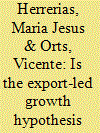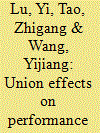| Srl | Item |
| 1 |
ID:
097826


|
|
|
|
|
| Publication |
2010.
|
| Summary/Abstract |
One of the missing pieces preventing us from understanding recent Chinese economic development is the role played by openness and capital accumulation in this process. The question is whether the sharp economic growth that the Chinese economy has experienced is another case of export-led growth due to the open-door policy or whether, on the contrary, this growth has been caused by high domestic savings and investment rates (and the consequent capital accumulation). To answer this question, we employed an empirical framework of the cointegrated vector autoregressive model. The empirical results show that both investment (in physical capital and R&D) and exports, as well as the exchange rate policy, are relevant factors in explaining China's long-run economic growth over the past 4 decades.
|
|
|
|
|
|
|
|
|
|
|
|
|
|
|
|
| 2 |
ID:
025246


|
|
|
|
|
| Publication |
New Delhi, Prentice-Hall of India Pvt Ltd., 1969.
|
| Description |
xii, 206p.Hbk
|
| Series |
Primer
|
|
|
|
|
|
|
|
|
|
|
|
Copies: C:1/I:0,R:0,Q:0
Circulation
| Accession# | Call# | Current Location | Status | Policy | Location |
| 015400 | 658.5/FAB 015400 | Main | On Shelf | General | |
|
|
|
|
| 3 |
ID:
190394


|
|
|
|
|
| Summary/Abstract |
The structural changes that the Chinese economy has been experiencing since its working-age population began to decline pose challenges for its further growth. First, as it loses its comparative advantage in labor-intensive activities, the share of manufacturing in its GDP has shrunk. Second, unproductive enterprises that are reluctant to exit the market tend to seek policy protection, which leads to the immobility of resource allocation. Third, the reallocation of the labor force from the highly productive manufacturing sector to the low-productivity service sector leads to the degradation of resource allocation. The inadequate exploitation of the potential of resource reallocation implies that the decline in manufacturing is premature. It is therefore important to combine market competition policy, industrial policy, and social protection policy to stabilize the development of manufacturing.
|
|
|
|
|
|
|
|
|
|
|
|
|
|
|
|
| 4 |
ID:
093854


|
|
|
|
|
| Publication |
2010.
|
| Summary/Abstract |
This paper empirically studies union effects on the performance of, and employment relations in, China's private enterprises. The study finds a positive and statistically significant union effect on labor productivity, but not on profitability. It further finds that unions lead to better employee benefits and increased contract signing in employment. These findings suggest that, in the era of transition from a centrally planned to a market economy, unions in China's private enterprises do promote workers' interests as unions do in other economies. And they do that without abandoning their traditional role of harmonizing employment relations, as required by the Party.
|
|
|
|
|
|
|
|
|
|
|
|
|
|
|
|